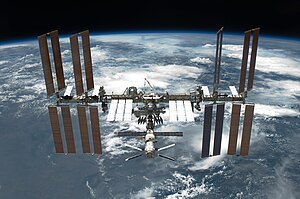
Origins of the International Space Station covers the origins of ISS. The International Space Station programme represents a combination of three national space station projects: the Russian/Soviet Mir-2, NASA's Space Station Freedom including the Japanese Kibō laboratory, and the European Columbus space stations. Canadian robotics supplement these projects.
In the early 1980s, NASA planned to launch a modular space station called Freedom as a counterpart to the Soviet Salyut and Mir space stations. In 1984 the ESA was invited to participate in Space Station Freedom, and the ESA approved the Columbus laboratory by 1987.[1] The Japanese Experiment Module (JEM), or Kibō, was announced in 1985, as part of the Freedom space station in response to a NASA request in 1982.
In early 1985, science ministers from the European Space Agency (ESA) countries approved the Columbus programme, the most ambitious effort in space undertaken by that organisation at the time. The plan spearheaded by Germany and Italy included a module which would be attached to Freedom, and with the capability to evolve into a full-fledged European orbital outpost before the end of the century. The space station was also going to tie the emerging European and Japanese national space programmes closer to the US-led project, thereby preventing those nations from becoming major, independent competitors too.[2]
In September 1993, American Vice-President Al Gore and Russian Prime Minister Viktor Chernomyrdin announced plans for a new space station, which eventually became the International Space Station.[3] They also agreed, in preparation for this new project, that the United States would be involved in the Mir programme, including American Shuttles docking, in the Shuttle–Mir Programme.[4]
- ^ ESA - Columbus
- ^ "ISS". Astronautix.com. Archived from the original on 20 January 2017. Retrieved 31 December 2020.
- ^ Heivilin, Donna (21 June 1994). "Space Station: Impact of the Expanded Russian Role on Funding and Research" (PDF). Government Accountability Office. Retrieved 3 November 2006.
- ^ Dismukes, Kim (4 April 2004). "Shuttle–Mir History/Background/How "Phase 1" Started". NASA. Archived from the original on 16 November 2001. Retrieved 12 April 2007.